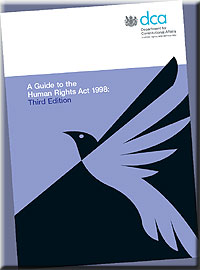 |
||
 |
 |
|
|
|
||
|
The government has embarked upon a campaign to encourage police and other public sector workers to adopt a common-sense approach to human rights. "Human rights are there to protect the public, not put people at risk.Too often much of the real importance of human rights has been clouded by nonsense. Human rights and common sense go together. There have been problems with how human rights and the Human Rights Act have been interpreted. It is my responsibility and that of my department to make sure staff in key frontline services are properly informed about the legislation and how it is meant to work." There is also an awful lot of nonsense written about the impact of the Human Rights Act upon health & safety legislation. The Department for Constitutional Affairs and Ministers will work with a range of organisations including police, probation, education and health to ensure common-sense solutions to human rights problems. The booklet, Making Sense of Human Rights - A Short Introduction, is designed for officials in public authorities to assist them in working with the Human Rights Act 1998 and to raise their awareness of human rights. The United Nations Universal Declaration on Human Rights was made in 1948. In 1951 Britain was the first member of the Council of Europe to ratify the European Convention on Human Rights, which it helped draft. Source: GNN
|
||
|
|
||
